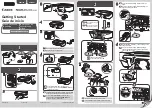
4.2 BIDIRECTIONAL PRINT POSITION ADJUSTMENT
This section describes how to adjust the bidirectional print position to ensure correct printing alignment.
4.2.1 Overview of Bidirectional Print Position Adjustment
This printer prints characters when the carriage is moving in either direction (i.e., from left to right or from right to left).
Adjustment is necessary to ensure that the printing of characters in one direction is properly aligned with the printing
of characters in the opposite direction. For example, if the the print position is out of alignment, printing of a vertical
line shows staggering because of the skew effect.
It is important to readjust the bidirectional print position if anything has been done to the gear arrangement that might
affect this printing alignment. By making the timing lag slightly during printing while the carriage moves from right to
the left, it is possible to line up printing done in this direction so that it will match printing done in the left-to-right
direction. The procedure to alter the timing is called the bidirectional print position adjustment.
The degree of bidirectional printing skew differs, depending on the unique characteristics of each printer mechanism.
For this reason, there is no standard skew correction value that can be applied to each printer. The unique skew
correction value for each printer has to be wriien to EEPROM on the main board.
Whenever the printer mechanism, or the main board itself, is changed during servicing, the bidirectional print position
must be readjusted and a new bidirectional skew correction value must be wriien to EEPROM.
4.2.2 Bidirectional Print Position Adjustment Procedure
Initial operation
Before performing the bidirectional alignment adjustment, complete the initial operation below:
* Position the adjustment lever at position 0.
* Verify that the DIP switch setting for high-speed draft is off (DIP switch 1-6 is on).
Verify that the DIP switch setting for country is U.S. (DIP switches l-l, 1-2, and 1-3 are on, and 1-4 is off).
* Load paper.
Feed at least 10 lines.
* Turn the printer off.
NOTE:
The printer enters unidirectional printing mode automatically from the top of form to the line 10 position on the
paper, because this improves paper-feed accuracy, Therefore, you must perform the bidirectional alignment
adjustment after 10 lines or more have been fed.
Adjustment operation
The alignment procedure is as follows:
1.
Turn the printer power on while pressing the ALT,
and LOAD/EJECT buttons.
2.
The printer enters draft mode and prints the reference value and “I” characters for 4 lines.
4-4
Summary of Contents for LQ-1170
Page 1: ...LQ 1170 24 PIN DOT MATRIX PRINTERS TM LQ8 1170 ...
Page 2: ...L Q 8 7 0 1 1 7 0 SERVICE MANUAL EPSON T Printed on recycled paper ...
Page 101: ...10 9 91 Yes NO Replace pluggable chips on main board 5 6 ...
Page 110: ...Table 5 4 Repair of the Power Supply Board Continued 5 15 ...
Page 118: ......
Page 121: ...REV A Figure 6 2 LQ 870 Lubrication Points 6 3 ...
Page 122: ...REV A Figure 6 3 LQ 1170 Lubrication Points 6 4 ...
Page 134: ...1 I II ...
Page 135: ...REV A Q m u D w IL 0 1 xl Figure A 3 CO60 DRV Board Circuit Diagram A 11 ...
Page 136: ...Figure A 4 CO60 PSB Board Circuit Diagram A 12 ...
Page 138: ...LO SLOE002 OWO9 1Nd 0 9 0 3 5 f l P I 11 I 01 I 6 I 8 1 L 9 I 9 I B I I2 I 2 I 1 ...
Page 142: ...REV A Fl 24ov T3 IsA I I II II AL I CU rl Figure A 10 C060 PSE Board Component Layout A 1 8 ...
Page 143: ...LMS d10 IP IMS dla ...
Page 144: ...REV A A 4 EXPLODED DIAGRAM Figure A l 2 1 Exploded Diagram for LQ 870 A 2 0 ...
Page 145: ......
Page 146: ...REV A Figure A 13 1 Exploded Diagram for Model 5DlO A 22 ...
Page 147: ... 5 2 5 610 c 3 5 9 0 El ...
Page 149: ...REV A A 5 CASE OUTLINE DRAWING Figure A l 4 1 Case Outline Drawing for LQ 870 A 25 ...
Page 151: ...lllllll IllI l l IIIIII II0 IIll III1 I I I C O 6 1 M A I N B o a r d A 3 7 ...
Page 152: ... U nRonenl2 i i C O 6 0 HAIN B t _1 m r OL J IIA IS I 19 CNI 36 I I8 I 23 IS ...
Page 153: ...a i iJ 0 E fig tfti I z ...
















































